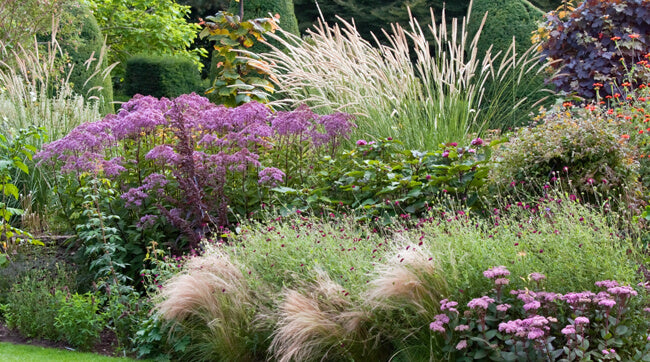A good planting bed doesn't just happen. Don't hesitate to draw up a plan so you can preview the possibilities and create the best interrelationships. Be your own outdoor architect!
Points to consider:
Before you go out and buy your perennials, sit down and have a good look at the growing conditions in your garden and choose your cultivars accordingly:
- Soil type: clay or heavy soil, sandy or light soil, humus;
- Drainage: well-drained or soggy soil;
- Sun exposure: full sun, shade, partial shade;
- Climate: the ability of a species or variety to resist wind, rain, humidity and cold (hardiness);
- Resistance to disease and pests;
- Ease of maintenance.
A well-designed flower bed

Remember, the best gardens are the ones where each plant accentuates the appeal of its neighbours.
- Look for balance in your garden, placing the tallest plants behind and the smaller ones in front where they'll be appreciated.
- Create rhythm in your flower bed by integrating various forms, such as upright, weeping and creeping. Also, exploit colour and foliage variations.
- Integrate several plants in the same species according to the size of your flower bed. The larger the flowerbed, the more plants of the same species it takes. This creates homogenous areas that have visual appeal from afar.
- Stagger flowering periods so you're never without blooms.
Planning on paper

To simplify the planning process here are a few easy steps to follow:
- Take a piece of paper and divide it into four columns, one for each flowering period:
- late April to late May;
- June to mid-July;
- Late July to late August;
- September and October.
- In each column mark down the plants you want and group them according to their height at maturity (make sure you have plants in each height category):
- low;
- average;
- tall.
- On a piece of graph paper do a rough sketch of your garden indicating the location of the plants you have selected. Keep in mind the ornamental value of each one:
- general habit: upright, weeping, climbing;
- proportions: height and spread;
- form and colour of the foliage;
- flowering period and form and colour of the flowers.
Playing with varieties

Playing with a variety of different flower types gives rhythm to a floral composition. A garden with perennials can be very interesting if you have lots of variety, both in the flowers and in the foliage. If they don't all fit together quite right after the first year or two, simply shuffle them around for the next year.
When designing a perennial garden, start with species and cultivars that create a particular accent, because of either their height or their flowers. These plants then serve as focal points around which you build the rest of the picture.
Around these focal plants you then add other perennials that harmonize the overall picture. Bear in mind the particularities of each plant you select. Some can be very invasive, others may lose their leaves during the growing season (particularly some spring-blooming plants).
Position your plants so you get some sense of visual flow between the different species and cultivars.
What about maintenance?
Most perennials demand little, but that doesn't mean none.




